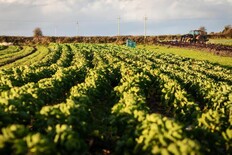Potato production in Ireland is a specialised game. However, you could argue that the crisping and chipping sub-sectors are even more specialised. As such, these sectors are generally small – confined to a handful of specialised growers.
Accessing up-to-date, relevant information on varieties can be challenging for these growers, who generally rely on work done in other countries to help inform their decisions.
Last year, Dublin-based Haggard Stores set out to help close this knowledge gap by planting variety trials and inviting growers and breeders to an open day.
After a successful event, they decided to continue this year – with over 50 varieties on display. The Irish Farmers Journal attended the open day in north Dublin.
Crisping varieties
Around 45,000t of crisping potatoes are grown in Ireland each year, much of which is destined for Tayto Snacks in Meath. According to Stephen McCabe, agronomist at Haggard Stores, the types of crisping varieties grown in Ireland depend on when the factory wants the crop.
For instance, some varieties are delivered straight from the field to the factory in August or September for immediate cooking. Other varieties that store well will be kept until the following August before being delivered.
The sugar content of the potato and how it changes during storage are key factors in determining the market segment the variety serves.
“Lady Rosetta, for example, is a variety used straight from the field. Its sugars are low and stable at the beginning of the year, but as it matures in storage, they become too high,” McCabe explains. High sugar content in the potatoes results in dark crisps that aren’t suitable for use.
McCabe explains that each variety in the trial will be harvested, stored and cooked as part of the evaluation process. When asked about the standout varieties, he mentioned that Punchy appears to be high-yielding and seems to meet all the requirements for early cooking.
Other varieties like Lady Alicia and Beyoncé, which were first trialled last year, appear to be suitable for medium-term storage. Additional varieties, like Sorentina, also seem to yield well and store effectively for longer periods.
Chipping varieties
The market for native chipping potatoes continues to develop in Ireland, in part due to supply chain adjustments as a result of Brexit. However, growing potato varieties that can be turned into chips in Ireland is still challenging.
McCabe explains that since the chippers in Ireland were accustomed to the English Markies variety, Irish growers started growing it. However, the variety doesn’t really suit our climate, as it’s late-maturing and prone to certain diseases like alternaria, which are hard to control here.
The challenge is to find a variety which can mature earlier while meeting all the quality parameters that Markies do, he said. These parameters include having a long, oval shape, yellow skin and yellow flesh, and remaining stable in storage.
Some potential replacements for Markies that stood out were Kingsman, Elland, Limus, and a coded variety 6675 from Northern Ireland’s Cullen Allen Ltd.
All of these varieties seem to have great yield potential, but their storage quality will become clear as the trial progresses.
View from the breeders
Variety breeders are focused on developing breeds for a future where crops must be produced with lower chemical inputs and greater resilience. This was according to Tigran Richter, director at the German-based breeding company Norika, and president of the European Potato Trade Association, Europatat, who we caught up with on the day.
Richter said that under the Farm to Fork Strategy, along with continued pressure from climate change, increasing input costs and evolving consumer preferences, a significant transformation in agriculture is approaching.
He highlighted that as breeders, their responsibility lies in being part of the solution, by providing improved genetics to address these challenges.
This was evident in the varieties under trial that day, with considerable importance being placed on traits like virus, blight and sprouting resistance, as well as characteristics that enhance nutrient use efficiency.
“We will not see varieties grown on 250kgN/ha anymore, we will see them go to under 100kgN/ha while still achieving the yields and quality,” Tigran said.
A difficult year
Shay Phelan, crop specialist with Teagasc, said that it’s been one of the toughest years for potato growers in living memory. The potato crop area is down by around 1,000 acres this year, and most growers were delayed in planting by up to a month due to wet weather.
Crops soon faced a drought, which has resulted in a reduced number of tubers per plant in many cases. Blight pressure over the past six weeks has been severe, with growers struggling to get their timings right while battling poor field conditions.
Crops are running behind this year, with few burned off yet. As a result, the main crop harvest is likely to be slightly later this year, he said.
The high disease pressure will also pose a challenge for haulm destruction using a flail, with growers being advised to opt for chemical desiccation instead.
That said, markets are holding firm and with little carryover from 2022, the indications are that prices will be good for the season ahead.






 This is a subscriber-only article
This is a subscriber-only article

















SHARING OPTIONS: